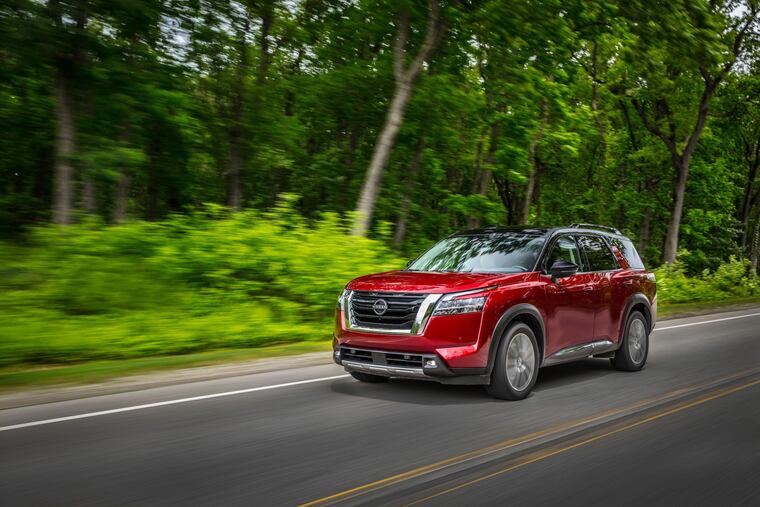2022 Nissan Pathfinder: Mostly on track vs. two rivals
The engine may be the same, but the nine-speed transmission is all new — one of the biggest improvements over the 2019 model.

2022 Nissan Pathfinder SL 4WD vs. 2022 Jeep Grand Cherokee L Limited vs. 2022 Volkswagen Atlas SEL 4Motion: “Bargain” three-row SUV competition.
This week: Nissan Pathfinder
Price: $47,435 as tested. Premium package added heated second-row captain’s chairs, Bose 13-speaker stereo, tow hitch, and 20-inch wheels for $2,900; lighting package, $795; SL black package, $470; floor mats, $255.
Conventional wisdom: Car and Driver liked the “quiet cabin, impressive towing capacity, plentiful storage cubbies and bins,” but not the “lackluster handling, numb steering, loaded model costs more than Telluride but isn’t quite as nice.”
Marketer’s pitch: “Return to rugged.”
Reality: So many improvements, except …
What’s new: Reinvented from the ground up, according to Nissan, it looked like a Ford Explorer. Not a bad model to emulate.
Up to speed: The 3.5-liter V-6 — a holdover from the previous generation — created 284 horsepower and definitely moves the SUV quickly, reaching 60 in 6.6 seconds, according to Car and Driver. This shaves almost a second off the 2019 model tested.
Passing was much easier than in last year’s model. And even though I didn’t happen to climb any big hills with it, I’m going to venture that taking on hills will be better. Why? Read on.
On the down side, pickup from 40 mph is still far too rapid, and the Pathfinder can get away from you.
Shifty: The engine may be the same, but the nine-speed transmission is all new, and that’s important. This is one of the biggest improvements over the 2019 tested, which featured a power-sapping CVT.
The transmission is shiftable, and the paddles do the job nicely. It could be slow to respond in higher gears, but that’s to be expected.
I detected a bit of hesitation when the weather turned cold and damp during test week.
The shifter is a squared-off version of a Tiptronic lever. Push forward for Reverse and pull for Drive or Shift. Among new takes on shift levers, it’s nice, much more intuitive than buttons or a dial.
On the road: The ride is much smoother than the Grand Cherokee L. The Jeep was heavy and truck-like, while the Pathfinder continues with its easier handling that was the name of the game even before this year’s redesign. The Atlas was sporty but mainly comfortable.
Mr. Driver’s Seat adjusted to the driving capabilities of the Pathfinder from the start. A trip through the countryside to Delaware offered good handling and road manners, and a highway trip to Philadelphia felt comfortable, as well. It’s a great improvement over the previous generation, which wandered on highways and sucked the fun out of country roads.
One troublesome point, though, is damp weather. On Day 6, the road was wet from earlier rainstorms, but no puddling or rain at the time. Every move I made that morning felt a little skate-y. The Pathfinder got away from me on a curve I’ve driven hundreds of times in similar weather at similar speeds, and it began to skid. Fortunately I didn’t panic; I simply let off the gas, and the vehicle soon restabilized. (As for panicking, I’m sure the driver in the oncoming lane did.) It’s worth checking into if you’re in the market.
Driver’s Seat: The Pathfinder interior is handsome, at least when trimmed out like the test vehicle. The leather seats are not uncomfortable, but they don’t have a lot of give. I thought that I could be happier sinking in a bit more.
Fixed analog gauges are easy to read and controls nice to operate, the most standard issue of the vehicles tested. A pretty ebony infotainment center and black leather dash livened things up. A little phone and iPad holder for passengers above the glove box adds storage.
The steering wheel does not telescope as much as I’d like, leaving me feeling like a T-Rex. Side-view mirrors are noticeably small and make passing a chore.
Friends and stuff: The rear two rows are about as comfortable as the front, which is to say acceptable. The middle row adjusts forward and rear, and even pushed almost the whole way forward provided good accommodations for Mr. Driver’s Seat’s legs, when seated behind a Mr. Driver’s Seat-size human. Headroom and foot room are also good.
The rear seat provides horrible leg, foot, and knee room when the middle row is pushed back, and this increases to simply uncomfortable knee room with the seat slid forward. It sits really low to the floor, but headroom is nice.
A central console holds lots of stuff and comes out for third-row access.
Cargo space is a tiny 16.6 cubic feet in back, 45.0 behind the second row, and 80.5 behind the first.
Owners can tow as much as 6,000 pounds in the right configuration.
Play some tunes: Here’s my first Pathfinder without a bevy of stereo buttons, and it’s a joy. A few buttons across the bottom of the screen offer source choices, dials control volume and tuning, but then it’s into the touchscreen you go. It all functions admirably.
Sound from the system is pretty nice, about an A-.
Keeping warm and cool: Dials operate the temperature while buttons control everything else. It’s certainly easier to read than the Jeep.
Fuel economy: I averaged just under 21 mpg in the usual Mr. Driver’s Seat round of testing.
Where it’s built: Smyrna, Tenn.
How it’s built: Consumer Reports predicts the Pathfinder reliability to be a 2 out of 5.
Next week: 2022 Jeep Grand Cherokee L Limited.